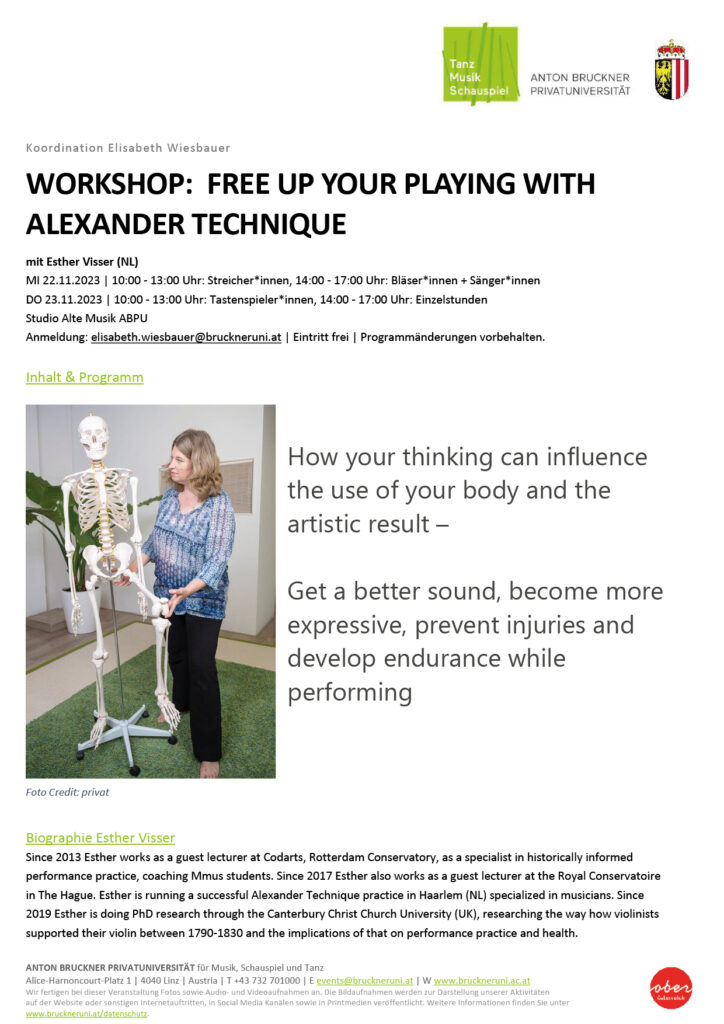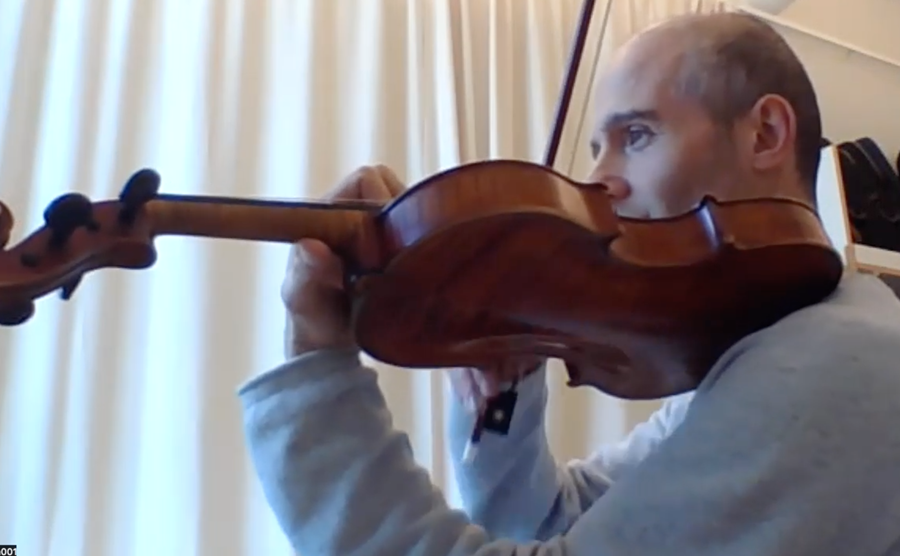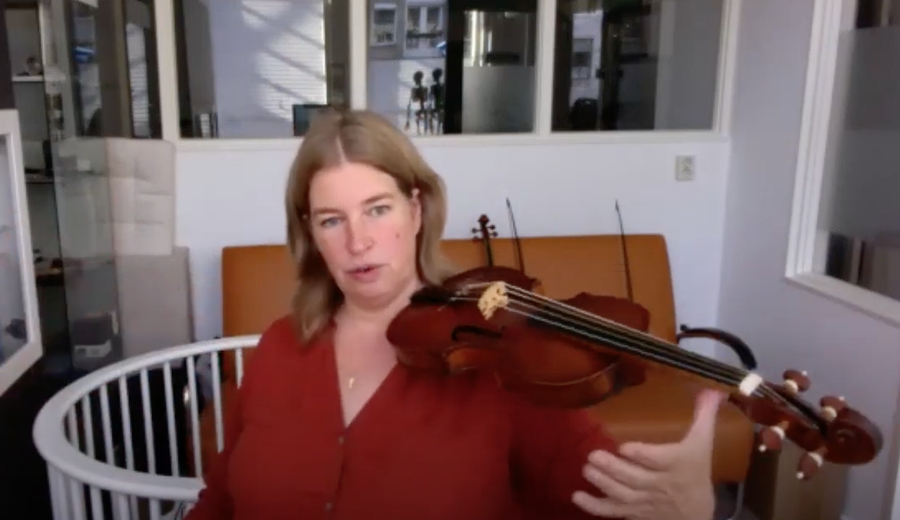
The 17th week in my experiment
Hi everyone,
This is the 17th week of the experiment on playing without a shoulder rest and / or chin rest. Here are some updates and some feedback.
Thank you for sending me your videos, it’s really important for my research. Some people just finished the whole 12 week program, sent their last video and filled out the exit survey. Fantastic, thank you so much! The majority however is still about half way in the program and that is perfectly fine, please do take all time you need and don’t hurry.
It is still possible to start taking part in the experiment. Again, some more new participants joined as well, welcome to James from France! Many people already filled out the entrance survey. Thanks. If you didn’t do it yet, please do so before you start the lessons.
If you know more people who like to join, for example starting this or next month, this is still possible through my website. If you missed the newsletter last week, you can still read it here. There is a collection of past newsletters at my website available too.
Please be welcome to join the Zoom session next Wednesday 11.00 AM (Dutch time) if you want… Just to meet or to ask some questions. Would be nice to meet up. You can watch Zoom sessions back on the login page where the video lessons are, as well.
“I think your research is very important and I think you are very right on all the points you raised. I am so thankful that your talk about this, because almost every musician has unhelpful habits.”
– Jun Keller, Vienna Philharmonic Orchestra,
participant in the experiment
17th Zoom session
Last Wednesday we had a 17th zoom session with some participants of this experiment. It was lovely. If you want to watch it: I recorded the session and there is a link to it in the login page under the video lessons.
Andreas from Belgium, Attilio form Sweden, Daniela from Italy and Ingrid from The Netherlands joined me this time.
Andreas Moulin is a Belgian violinist and pianist, living in Brussels. He started playing violin when he was 4 years old. When he went to the ‘Music Academy’ (primary and secondary school) he had a very severe teacher, who forced everyone to play without a shoulder rest without explaining anything about the balance, how to do that. It was a traumatic time. When he was 18 he decided to be a musician, studying at the Royal Conservatory in Leuven, and tried to restore his connection with the instrument again. He was allowed to use a shoulder rest, but he also didn’t know how to use one and he didn’t like it. His playing was even more tensed when using a shoulder rest, he could not feel his body anymore, there was something in between. After 1,5 years he removed the shoulder rest because he wanted to feel the violin and since then he plays without it. When he started conservatory he developed a chronic pain. He had Alexander Technique lessons with my Alexander Technique colleague Mark Pijpops. Andreas now is a graduated musician and also composes music. He is very interested now to learn to play without using a shoulder rest in a conscious way for the first time in his life.

Andreas told us that he also learned a lot from all these injuries and knows much more about the body now. He feels frustrated, looking back, that his teachers in conservatory did not teach them anything about how the body works, how the mind works, how anatomy is built up. He had to do it completely alone. Some months ago he even had to go to hospital because of severe pain in his lower back and the doctors think that it is a reaction to the high amount of pain he has experienced in the past, the connection with the nerves and his brain is a bit disturbed.
When Andreas told this, I felt very motivated to invest in this process with him together. I think that when he learn a better balance for his violin, probably his whole body will relax and hopefully also the other pains will fade out. Let’s go for it!
Andreas just finished the 5th lesson (glissandi). For him, the second lesson (balancing on only the thumb) had been the hardest until now. We spoke about the contact of the violin on the collarbone and Andreas told us that his violin is partly on what he calls ‘the fleshy hill’ and partly on the bone. Otherwise the violin is 100% horizontal and he feels that the G string is a bit too low for the bow arm. For me, that is the same. However, the violin still is much more horizontal than when people use a shoulder rest and the advantage is that gravity works with you. Of course for this, one needs to be able to let the right shoulder lying down while raising the right arm. This is something you can learn with Alexander Technique lessons.


We also spoke about it that it is possible to sometimes make the violin tilt a bit more by pushing and turning with the left hand, but the danger is that people start to do this all the time, which creates a lot of tension. If you apply it really as an exception, then it can be a nice addition to the playing, for example to make a deeper sound.
Andreas said it very nicely: “You need to be able to move all the time”. In Alexander Technique we call this ‘to be available to move’ all the time. It’s about finding freedom between all the fixed points that forms the balance. In my opinion this also should be the case with the connection of the head on the atlas, while playing. Many violinists lock this part completely and it is not ‘available to move’ anymore.

Andreas shared without that lately he decided to focus on being free while playing, also in concerts and during recording, in stead of caring to play in tune for example with a completely blocked physical feeling. In the end, it’s about the music and not about being perfect.
He also shared that he thinks that a lot of conservatory teachers just don’t know themselves enough, they have a lack of knowledge for example about anatomy. I completely agree with him. Especially very talented musicians often have no idea, as for them everything came easy. It also is interesting to think about the selection process of becoming a professor at a conservatory. Here in Holland for example often people just get invited as they are a leader or first wind player in the Concertgebouw Orchestra, while that does not have to mean that they have didactical skills.
Daniela told us that in Italy there is a law, that if you have a position in an orchestra you are not allowed to teach in a conservatory, they are not allowed to have double jobs! So that is the other way round… and that also gives a lot of problems, as you study with someone who has no idea what it means to play in orchestra!

Daniela told us that when she was in conservatory and practiced Paganini, she was in big pains but never told this to her teacher. She just took medicines until the day of the exam. It was something everyone in her class was doing, just taking medicines when you play Paganini. Amazing, isn’t it?
She had to prepare 6 caprices for the exam and the committee picked 2 of them to play. Some exams took more than 4 hours. Her first teacher would not even teach her if she did not have a red spot on her skin in the neck from the practicing so she was hurting herself to make a red spot visible…

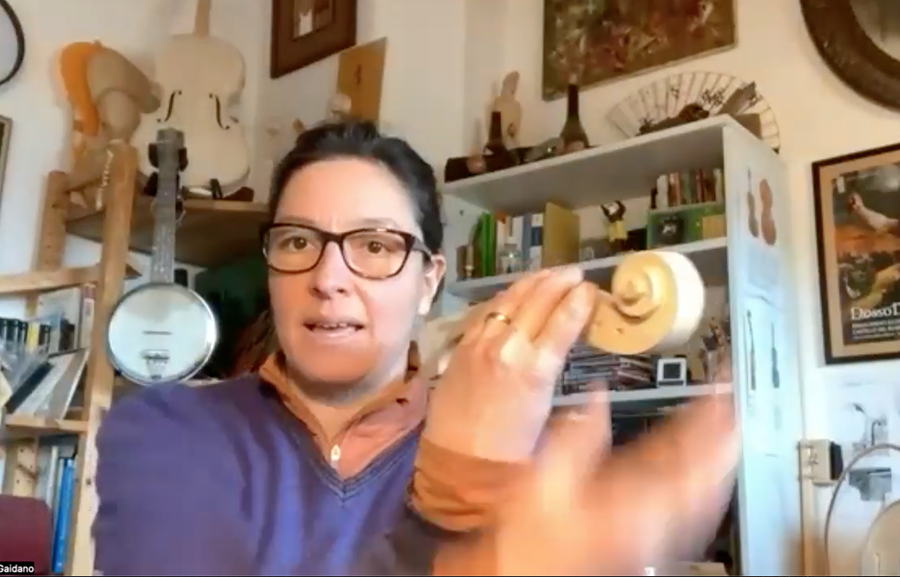
Daniela’s first violin lessons were about holding the violin completely with the neck and even being able to jump up and down with no support of the left hand on the violin. Can you imagine? The teacher was even hanging her bag on the scroll of the pupils violin. Really horrible.
There were so many violin students in that time in her generation in Italy, that it just worked like a filter: The ones that got pain just dropped off and no one worried about that. The were only a few orchestras in Italy and every year a lot of graduates from the music academies.

Andreas told us that in Belgium there is an institute for artists in pain, for example actors with stage fright, musicians with injuries and so on. Once, they wanted to do an experiment with two groups: violinists with pain and violinists without pain (compared research)… but is was not working out, as they could not find enough violinists who did not have any pain! Andreas really was shocked by this reality and he realized he was by far not the only one.


Then Andreas took his violin and we worked position changes. He often was told that the thumb should go first, in shifting downwards, but I encouraged him to try first the fingers and then the thumb. Because in that way you can keep supporting and balancing the violin all the time without the help of the head. If you go first with the thumb, it is dragging the violin away from you.


We also spoke about it how one could play without thinking in positions. This is something more needed when playing with using a shoulder rest, but when we balance the violin, it is important to keep the support going all the time.
When Andreas played a scale for me, I noted that somehow he was squeezing a bit in his left arm pit, which was causing his left elbow to stay too much to the centre when he had a string crossing for example from the G to the D string. I encouraged him to freeze for a moment (see first photo below) and then asked his left shoulder and arm pt, if there could be anything there that could be softer or work less hard. Immediately his elbow dropped a few centimeters. The shoulder joint should be ‘available to move’ as we talked about earlier. This helped a lot, just check the difference in the second photo here under.
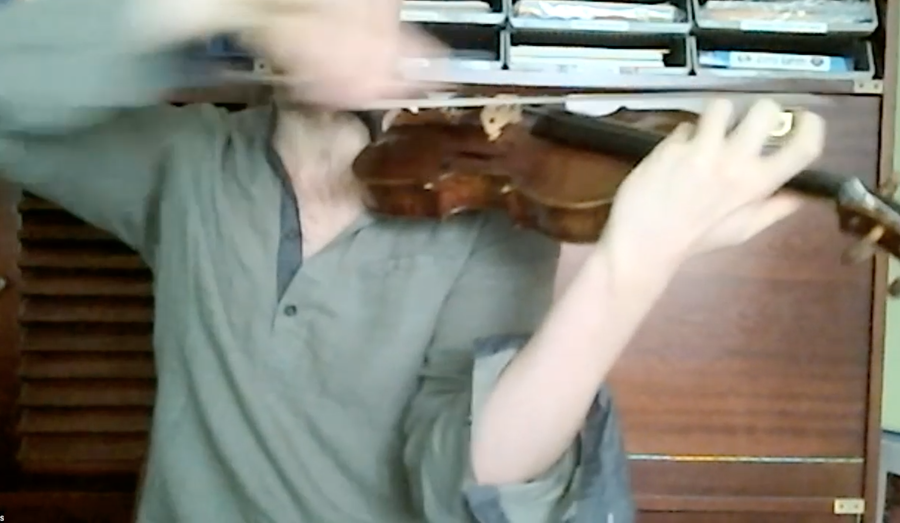


Andreas told us about an exercise he once learned during a masterclass with Lydia Bushkova, it is called the ‘Milstein exercise’, I didn’t know that once before! It goes like this and is meant to prevent violinists form squeezing the first two fingers together:
- put the neck of the violin between your first and second finger
- play the C# on the A string with your second finger
- tap the string with your pinky and put it on the string, probably it has a nice round shape now
- take your first finger back to the normal position
This gives a nice balanced hand position. Thanks, Andreas!

We also had nice discussion about starting to teach children playing in first in third position, and maybe with the thirst finger and not with the first finger!

Attilio had a question about the fingering in Paganini bar 11. I just write it here if more people have the same question: 134142032314.
Attilio had the Nuova Scuola Violinistica Italiana with him, written by Francesco Sfilio, who was a student of Sivori, who was a student of Paganini. Sfilio writes in this book sometimes to lift the collar bone towards the violin and Attilio asked me what I think about that. I answered that I think he must have meant to do this as an exception, like a special effect to have a deeper sound on one note for example. I can not imagine that he would have meant to do this all the time, but I will have a look in the book again and see if I can make sense of it! Thanks, Attilio!
Daniela joined the conversation again and shared that she finds it interesting that in that book the comparison between playing mandolin and violin was made. We discussed the fact that Paganini was a guitar and mandolin player as well, and how that might have influenced his left hand technique. Please watch the zoom session back if you are interested in this!
Daniela also asked if I put my first finger someone when I play the open string in the first bar in Paganini, but I think this is not needed. It goes very fast by…I think in such short moment you can just keep the hand open and balance on the thumb, but on longer notes I do use the support of a finger on another string.
After that we spoke about swimming and the swim holidays I organise in Croatia, haha… but that is not important for this newsletter.
Ingrid shared that she is using her head less and less on her violin now, very nice to hear. I am going to check out the exercises and ideas by Lydia Bushkova now, thanks for the inspirational zoom session!


Please take your time
It is important that everyone in this experiment enjoys the curiosity we have, and take part in a joyful and playful way. In that way, we learn the best. Don’t try too much to ‘do it right’…and don’t hurry. If you need more time, just let me know, keep me informed, and we take a bit longer. No problem!
Best regards, please let me know if you have questions,
Esther Visser




